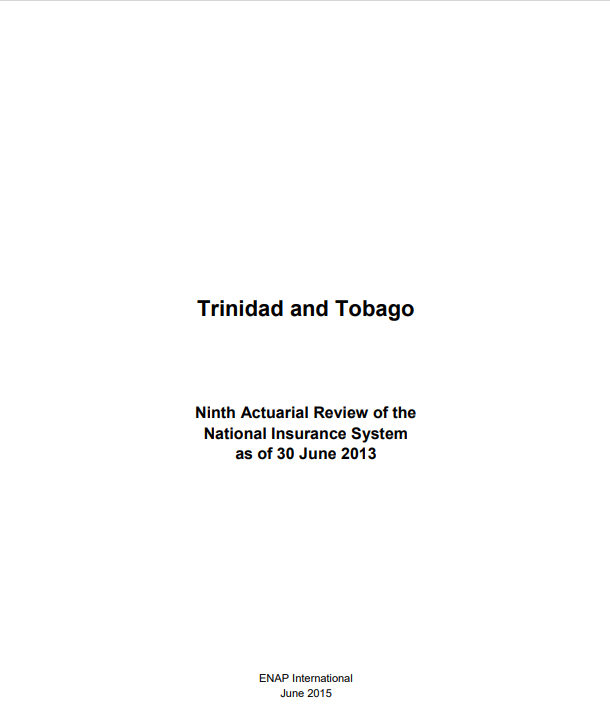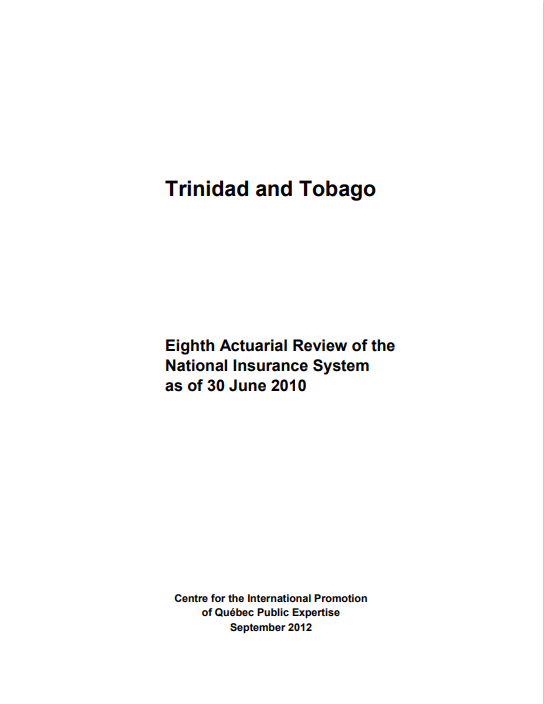Actuarial Reviews
Actuarial Reviews are intended “to review present and future financial developments of existing or new Social Security schemes, with the possibility to include analyses of the financial effects of major structural reforms in the case of existing schemes.”
The International Financial and Actuarial Service, International Labour Office (ILO FACTS)
The rationale for conducting Actuarial Reviews is:
- To ensure that the NIBTT is in compliance with the statutory requirement specified in Section 70 (1) of the NI Act. For the purposes of assessing the balance between the contributions and rates of benefits, an actuarial review of the system of national insurance shall be undertaken within three years of the date on which the first contributions under this Act are payable and thereafter at five-yearly or such shorter intervals as the Board may determine; and Section 22 (1), to set the upper limit on administrative costs of NIBTT based on: the recommendations of the actuary arising out of the periodic review of the National Insurance System.
- To determine whether the NIS is operating on a sound financial basis by assessing the short and long-term financial sustainability of the NIS; and
- To analyse the financial impact of modifications to current NIS provisions, and recommend modifications that may render the NIS a more effective and efficient mechanism for providing social insurance protection. Some of the areas of possible modification include:
- Coverage
- Financing of benefits
- Benefit payments
- Eligibility criteria
Actuarial Reviews have been an important tool in managing the success of Social Security Systems around the world.
- the increase in the minimum monthly retirement pension from $1,000.00 to $2,000.00 and
- the implementation of a slow and gradual increase in the contribution rate over a five (5) year period as shown in Table 1.
- to increase the minimum monthly retirement pension from $1,000.00 to $2,000.00 and to implement a slow and gradual increase in the contribution rate over a five (5) year period – January 01, 2006 9.9%; 07 January 2008 10.5%;04 January 2010 10.5% and 02 January 2012 11.4%.(25% increase in all benefits rates)
- The Maternity Grant and Special Maternity Grant increased to $3,750.00
- Funeral Grant increased to $7,500.00
- Minimum Retirement Grant increased to $3,000.00.
- Sickness and Maternity Allowance increases ranging from $120.00 to $1,384.80.
- Invalidity and Survivor’s increases ranging from $419.79 to $2,983.76.
- Employment Injury Benefits increases ranging from $173.33 to $2,000.27.
- The Minimum Survivor’s Benefits in respect of spouses, children, dependent parents was increased to $300.00 per parent and orphans increased to $1,200.00.
Actuarial Reviews

Tenth Actuarial Valuation of the National Insurance System as of 30 June 2016.
The present actuarial review covers the three-year period up to 30 June 2016.

Ninth Actuarial Review of the National Insurance System as of 30 June 2013.
The present actuarial review covers the three-year period up to 30 June 2013.

Eighth Actuarial Review of the National Insurance System as of 30 June 2010.
The present actuarial review covers the 5-year period up to 30 June 2010.
https://nibtt.net/Actuarial_Review/Act%20note%20Budget%20statement%20(revised)%20(1).pdf
abc
STRENGTH |VISION | SUSTAINABILITY
The International Labour Office (ILO) submitted the final report on Phase I of the 7th Actuarial Review of the National Insurance System (NIS) as at 30 June 2005. The conduct of the Actuarial Review was in compliance with Sections 22 (1) and 70 (1) of the National Insurance Act, Chapter 32:01.
The main objectives of the 7th Actuarial Review were to evaluate the financial status and assess the long-term financial sustainability of the NIS while maintaining an adequate level of insurance protection to the insured population and its dependents. In addition, the ILO also conducted analyses into the feasibility of modifying several NI provisions in response to requests by the Board of Directors, tri-partite stakeholders and the general public.
The senior actuary of the project, Mr. Gilles Binet, was in Trinidad for the period 11 June 2007 to 18 June 2007 to present the findings of the Actuarial Review. During his stay, Mr. Binet delivered a presentation of the draft ILO report to the Board of Directors and key stakeholders representing business and labour. In addition, the National Insurance Board of Trinidad and Tobago (NIBTT) presented NIBTT recommendations to the Honourable Prime Minister and his Finance Ministers on 09 May 2007 and to employers at a Special Presentation Meeting hosted by the Employers’ Consultative Association on 03 August 2007.
In reviewing the past performance of the NIS over the inter-valuation period 2001 to 2005, the NIS outperformed the forecasts from the 6th Actuarial Review which was conducted as at 30 June 2000. With regard to the insurable population, the actual number of contributors and beneficiaries exceeded the 6th Actuarial Review projections over the inter-valuation period.
On the revenue accounts side, contribution income, investment income and benefit expenditures exceeded projections. Administrative expenses exceeded projections in 2001/02 and 2003/04. This was attributed to settlement of salary negotiations and payment of retroactive salaries for the periods 1999-2001 and 2002-2004.
On the balance sheet side, assets grew more rapidly than forecasted and there was significant growth in the benefit funds and reserves. The ILO considers the financial situation as at 30 June 2005 to be at least equivalent to the forecasts from the 6th Actuarial Review and has therefore concluded that the NIS is operating on a sound financial basis.
From a demographic perspective, the projections assume low birth rates, an increasing life expectancy that takes the HIV/AIDS pandemic into account and zero net migration rates. From an economic standpoint, the projections reflect a burst of short-term economic growth followed by a favourable long-term economic outlook.
Population projections conducted by the actuaries reveal that while the size of the general population is expected to increase by around 11% by 2055, the number of pension-age persons will practically triple, the number of children will significantly decrease by around 21% and the number of workers will decline by around 10%. These main findings significantly emphasize the Ageing Population Syndrome.
The NIS demographic (i.e., contributors and beneficiaries) projections conducted by the actuaries reveal that –
- the number of pensioners will continue to grow rapidly relative to the number of contributors,
- lifetime pensions will be payable over longer periods of time, and the pensioner support ratio is projected to move from about four (4) contributors per pensioner in 2006 to about one (1) contributor per pensioner by 2055. These main findings tell us that the NIS is still maturing.
Stakeholders’ proposals on improvements to current NIS provisions were taken into consideration in order to analyze the financial impact on the NIS, as well as, to assess the long-term financial sustainability of the NIS as a result of these proposals and funding requirements. Based on the actuaries’ analyses, the key recommendations are (among other things) –
- To increase the minimum monthly retirement pension from $1,000.00 to $2,000.00 and to implement a slow and gradual increase in the contribution rate over a five (5) year period as shown in the table below.
| Date of Recommended NIS Contribution Rate Increase | NIS Contribution Rate (%) |
| January 01, 2006 | 9.9 |
| 07 January 2008 | 10.5 |
| 04 January 2010 | 10.8 |
| 02 January 2012 | 11.4 |
(45% increase in all benefits rates)
